Answer these simple questions and we will find you the BEST prices
Which type of solar quotes do you need?
It only takes 30 seconds
100% free with no obligation

Get Free quotes from insulation specialists near you

Save money by comparing quotes and choosing the most competitive offer

The service is 100% free and with no obligation
- GreenMatch
- Insulation
- Garage Insulation
Garage Insulation: How to Insulate a Garage in the UK

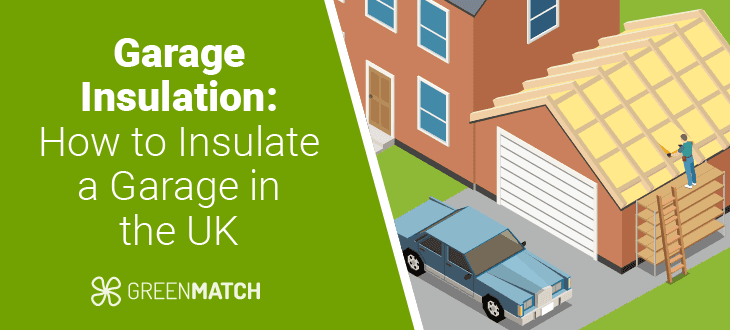
- The average cost of insulating a garage ranges from £35 to £45 per m2, though this can vary based on the size of the garage, the materials used, and whether you choose a DIY or professional installation.
- Insulating a garage can lead to significant energy savings by maintaining stable temperatures, especially in attached garages where cold air can seep into nearby rooms, affecting your home's overall efficiency.
- Most garages in the UK are built with single-skin brick walls, allowing you to choose between internal or external wall insulation, depending on your budget and specific needs.
Garage insulation is a crucial step in making your space more functional and energy-efficient. With over 11 million homes in the UK featuring garages, many of these spaces are often left underutilised due to poor temperature control.
Insulating your garage can significantly reduce heat loss in winter, keep it cooler in summer, and even provide soundproofing benefits. Whether you use your garage for storage, as a workspace, or a home gym, proper insulation can make it more comfortable and usable throughout the year.
In this guide, we’ll explore how to effectively insulate your garage, from selecting the best materials to installing insulation in walls, floors, doors and ceilings. Understanding this process can help you make informed decisions that could lower energy bills and enhance your home’s overall comfort.
Is garage insulation right for your home? Finding the right specialist can be time-consuming, but GreenMatch makes it simple. Just fill out our 30-second form, and we’ll connect you with up to four quotes—completely free, with no hidden costs or obligations. Let us make garage insulation easy and stress-free. Click below to get started!
- Describe your needs
- Get free quotes
- Choose the best offer
It only takes 30 seconds



What are the benefits of garage insulation?
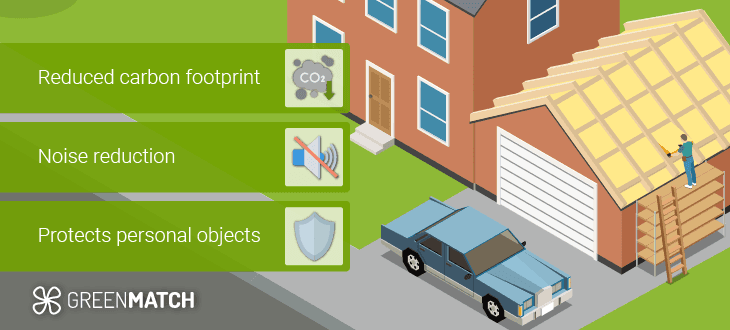
Garage conversion insulation provides numerous benefits that enhance your garage's functionality and improve your home's overall thermal efficiency. Garage insulation helps regulate temperature, preventing heat loss in winter and keeping the space cooler in summer. Here are some of the key benefits of garage insulation:
- Energy savings: In the UK, many homes have attached garages, and without proper insulation, cold air can seep into nearby rooms, reducing energy efficiency. Insulating your garage helps maintain consistent temperatures, lowering energy bills and boosting thermal efficiency for your garage and adjacent rooms.
- Lower carbon emissions: By cutting down on the energy needed to heat your home, garage insulation helps reduce your carbon footprint, contributing to a more sustainable, eco-friendly living environment.
- Increased home value: Improving your home’s energy rating with proper insulation can increase its value by up to 14%, making it a worthwhile investment.
- Noise reduction: Acoustic insulation in your garage minimises noise transfer from the garage to your home and helps reduce overall outdoor noise pollution, creating a quieter, more peaceful environment.
- Protects personal objects: Insulation helps reduce condensation in your garage, protecting electronics and other belongings from moisture damage and deterioration.
- Protects vehicles: An insulated garage shields your car from extreme temperatures, preventing freezing or overheating and prolonging its lifespan.
How to insulate a garage in the UK
Garage insulation in the UK is often simpler than insulating a home. Still, whether you choose a DIY approach or hire professionals, knowing how to insulate each part of your garage correctly is essential. Here's a step-by-step guide to help you insulate the areas of your garage effectively.
Wall insulation
Garage wall insulation is one of the most effective ways to boost thermal efficiency, as uninsulated walls can account for up to 33% of heat loss. Many garages in the UK are made from single-skin brick or block, which lacks a cavity wall for insulation. If your garage has double skin or cavity walls, it may already be insulated, but it's always best to consult a professional to confirm. For uninsulated double-skin walls, blown-in polystyrene insulation can be added.
Internal wall insulation (IWI)
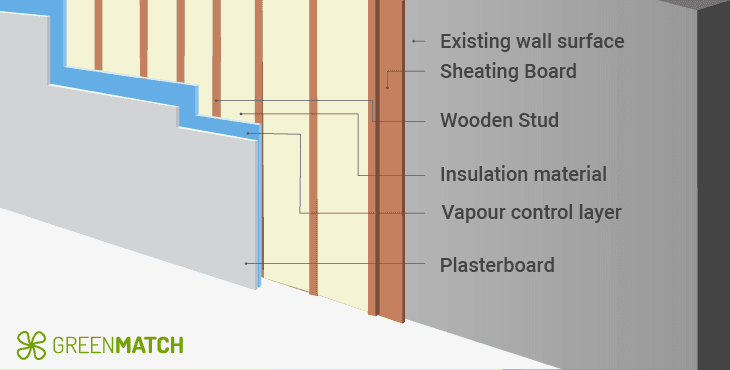
Internal wall insulation (IWI) is often more affordable and straightforward for garage insulation, especially those attached to your home. There are several methods of IWI to consider when insulating a single skin garage:
- Direct wall insulation: Rigid foam boards are attached directly to the interior walls, with sealed joints, a vapour barrier, and a plasterboard finish. This cost-effective method saves space and improves energy efficiency, making it ideal for flat walls with minimal damp issues.
- Batten wall insulation: Battens are fixed to uneven walls, with insulation placed between them and finished with plasterboard. This method is perfect for garages with irregular surfaces.
- Stud wall insulation: A secondary wall with a cavity is built, allowing for thicker insulation and room for wiring or plumbing. While it takes up more space, it provides excellent thermal performance and moisture resistance, especially for older or uneven walls.
- Insulating plaster: This method combines plastering with insulation, applied directly to the walls. It is space-efficient and breathable, preventing dampness, though it offers less thermal efficiency than thicker insulation materials.
Each method offers its benefits, making it essential to choose the one that best suits your garage’s structure and needs.
External wall insulation (EWI)
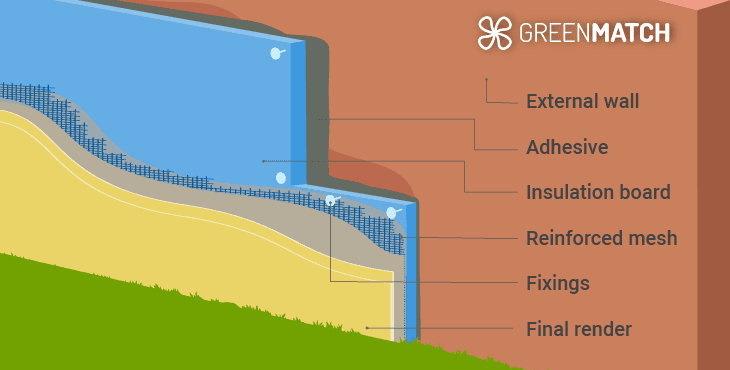
External wall insulation (EWI) is a highly effective method of insulating a single skin garage without sacrificing interior space. The process involves several layers:
- Adhesive layer: Bonds insulation panels securely to the external wall.
- Insulation board: The core layer, responsible for reducing heat loss by creating a thermal barrier between the interior and exterior.
- Reinforcement layer: Adds durability to the system, preventing cracks or damage.
- Fixing anchor and glass mesh: Anchors the insulation and secures the mesh for added strength.
- Primer: Waterproofs the insulation and prepares the surface for the topcoat.
- Finishing render layer: Serves both aesthetic and protective purposes, shielding the insulation from weather, UV rays, and mechanical damage.
EWI offers superior thermal efficiency compared to internal wall insulation (IWI) while also protecting against weather and saving interior space. However, it is typically more expensive than IWI. In some cases, especially in conservation areas or listed buildings, planning permission may be required.
Additionally, proper ventilation is crucial to prevent moisture build up, as EWI can reduce natural air exchange within the garage. Despite the higher cost, EWI is an excellent long-term investment in energy savings and comfort.
To find the best insulation method for your garage walls, it's important to consult with an insulation expert who can guide you in making the right decision based on your needs and budget. At GreenMatch UK, we can connect you with top insulation professionals in your area. Fill out our quick 30-second form to receive up to four free quotes—no hidden costs, no obligations. Click below to get started.
- Describe your needs
- Get free quotes
- Choose the best offer
It only takes 30 seconds



Roof insulation
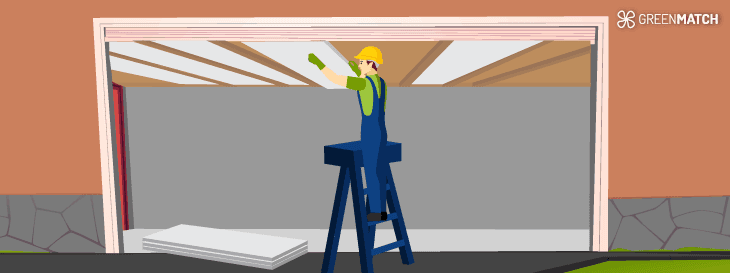
Garage roof insulation can be applied to both pitched and flat roofs, depending on the structure of your garage. For a pitched roof, the insulation process mirrors that of a typical house. Insulation is installed between the rafters to prevent heat loss and maintain a comfortable environment. Various insulation materials can be used, including rigid foam boards, fibreglass, spray foam, or even sheep's wool. Each material has its benefits, with rigid foam offering excellent thermal resistance and fibreglass providing a cost-effective option.
For a flat roof insulation, there are two primary methods: warm deck and cold deck insulation. A warm deck roof is the most common choice due to its superior thermal efficiency. This system's insulation is placed above the roof's structural deck, directly beneath the waterproof layer. The structure typically consists of a solid insulation board, timber decking, wooden joists, and a plasterboard ceiling. This setup keeps the entire roof structure warm, reducing the risk of condensation and heat loss.
In contrast, a cold deck roof places insulation between or beneath the roof joists, leaving an air gap between the insulation and the roof deck. While this method is more cost-effective, it requires proper ventilation to prevent moisture buildup and condensation, which can lead to long-term damage.
Floor insulation
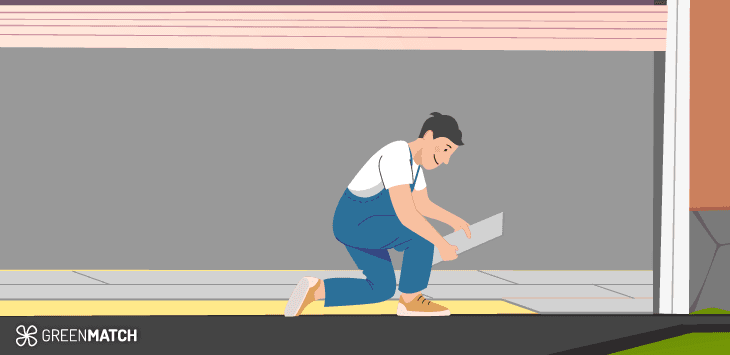
Garage floor insulation is an effective way to make the space more comfortable, especially during colder months when uninsulated floors can feel extremely cold. Garage insulation improves warmth and makes the garage more appealing if you plan to use it as a living space.
One of the best methods is to install rigid insulation boards, which provide excellent thermal resistance while minimally raising the floor height. Thin insulation boards are available to help maintain the original floor height. Still, in many attached garages, there’s often a step down to the floor, giving you extra height to work with.
In addition to thermal benefits, floor insulation can enhance the garage’s appearance. After installing the insulation, you can finish the floor with underlay, carpet, or even a timber deck for a polished look. If noise reduction is a concern, you can add acoustic matting over the insulation to reduce echoes, particularly in large or high-ceiling garages. Alternatively, insulation boards with built-in acoustic properties can minimise airborne noise and echo, making the space more comfortable and functional.
Garage door insulation
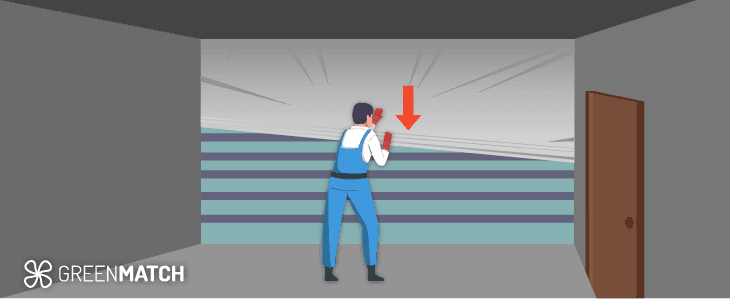
The garage door is often a significant source of heat loss, affecting the overall warmth of your garage, even if the rest of it is well insulated. If you're insulating a room above a garage, the most cost-effective starting point is to insulate the garage door. Draughts from an uninsulated garage door can easily escape through the ceiling and into the room above, reducing the effectiveness of insulation in both areas. By insulating the garage door first, you can significantly improve the thermal efficiency of both the garage and the room above it.
The most common method for garage door insulation is using reflective foil, which can be easily glued to the inside of the door. This is a cost-effective, DIY-friendly option that improves thermal efficiency. Another effective approach is attaching rigid foam boards to the inside of the door for added insulation.
Additionally, sealing gaps around the door frame is crucial for preventing drafts, even though it may be slightly less effective on its own. When combined with proper insulation, it can greatly improve overall thermal performance. Even if you don't plan to insulate the entire garage, insulating and sealing the garage door will make the space warmer and more inviting at a minimal cost.
The best way to insulate a garage is to address all key areas: walls, roof, floor, and garage door. Use rigid foam boards or materials with a high R-value. Insulate the garage door with reflective foil or foam panels, and seal gaps to prevent drafts, ensuring maximum thermal efficiency.
Materials for insulating a garage
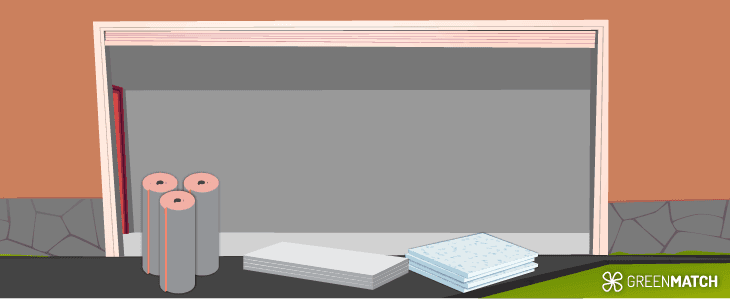
When selecting the best materials for garage insulation, it’s essential to consider three key factors: R-values, cost-effectiveness, and sustainability. The R-value measures thermal resistance—the higher the R-value, the better the insulation. Here’s a breakdown of the R-values for common insulation materials:
| Materials | R-value |
|---|---|
| Fibreglass | 3 to 4 per inch |
| Cellulose | 3.1 to 3.8 per inch |
| Sheep wool | 3.5 to 3.8 per inch |
| Spray foam | 3.6 to 7 per inch |
| Rigid foam boards | 4 to 7 per inch |
It’s important to note that spray foam and rigid foam boards come in different types, which can impact their R-values. When choosing insulation, weigh the R-value for energy efficiency, the cost based on your budget, and sustainability if environmental impact matters to you.
Rigid foam boards and spray foam offer the highest R-values, providing superior thermal efficiency. While sheep wool is more eco-friendly, its thermal performance is lower. Fibreglass is the most affordable option, but it has a lower R-value compared to other materials.
Working with a professional can help you choose the best insulation material for your needs and budget. However, finding the right specialist can be time-consuming, and comparing multiple quotes may lead to dead ends. GreenMatch UK simplifies this process by providing up to four free quotes—just fill out our 30-second form, with no hidden costs or obligations. Click below to learn more.
- Describe your needs
- Get free quotes
- Choose the best offer
It only takes 30 seconds



How much does garage insulation cost in the UK?
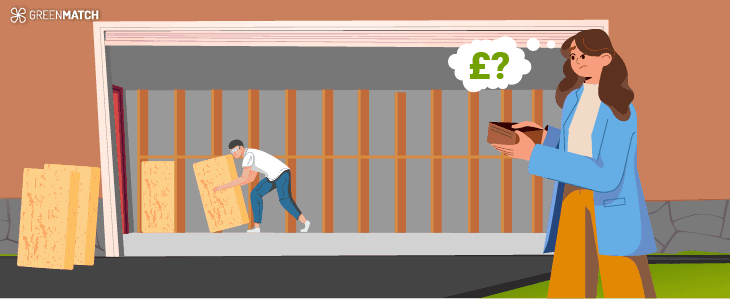
The cost of garage insulation depends on several factors including the size, materials used, and whether you choose to do it yourself or hire a professional. Typically, the cost to insulate a garage will range between £35 to £45 per m2. Here are the average costs for insulating different areas of your garage:
| Area | Cost |
|---|---|
| Garage door | £100 to £200 |
| Garage floor | £40 per m2 |
| Garage roof | £40 to £50 per m2 |
| Garage walls | £50 to £55 per m2 |
The cheapest way to insulate a garage roof or anywhere in the garage is by using fibreglass insulation, which is both cost-effective and easy to install, making it ideal for DIY projects. While fibreglass provides decent insulation at a low cost, it's important to choose materials based on your specific needs. Below are the average costs of common garage insulation materials:
| Material | Cost per m2 |
|---|---|
| Fibreglass | £10 |
| Rigid foam boards | £10 to £21.50 |
| Cellulose | £11 |
| Sheep wool | £19.75 |
| Spray foam | £21.50 or more |
Is it worth insulating a garage in the UK?
Insulating a garage in the UK is worth it, especially with the country’s varying climate. Proper insulation improves the comfort and usability of your garage. It helps reduce energy costs by preventing heat loss in winter and keeping the space cooler in summer. Insulation can make it more functional year-round, whether you use your garage for storage, as a workshop, or even as an additional living space.
Additionally, insulating a garage attached to your home can help regulate temperatures in adjacent rooms, enhancing overall energy efficiency and comfort. It also offers benefits like noise reduction, moisture control, and protection of stored items from extreme temperatures.
While DIY insulation is possible, professional installation ensures the job is done correctly, maximising energy savings and preventing issues like dampness or air leaks. Finding the right specialist can be challenging, but GreenMatch makes it easy. Fill out our 30-second form to receive up to four free quotes from trusted insulation professionals in your area—no hidden costs or obligations. Click below to learn more!
- Describe your needs
- Get free quotes
- Choose the best offer
It only takes 30 seconds



FAQ
Insulating a garage significantly improves temperature regulation, energy efficiency, and comfort, making it more usable year-round while reducing energy costs.
To insulate a garage in the UK, install insulation in the walls, roof, and floor using materials like rigid foam boards or fibreglass, and seal the garage door with insulation panels or weatherstripping to prevent drafts.
The best way to insulate a garage is to use rigid foam boards or fibreglass for walls, roofs, and floors. The garage door can also be insulated with foam panels while sealing gaps to prevent drafts.
To insulate a single-skin garage, you can opt for internal or external wall insulation using rigid foam boards. Additionally, consider adding floor and roof insulation, while sealing gaps around doors and windows to prevent drafts.

Caoimhe is an experienced content writer and researcher who is passionate about providing accessible information to every reader. With a background in English literature and Sociology, she combines the two disciplines to create cohesive, well-thought-out, and well-informed pieces.
We strive to connect our customers with the right product and supplier. Would you like to be part of GreenMatch?

